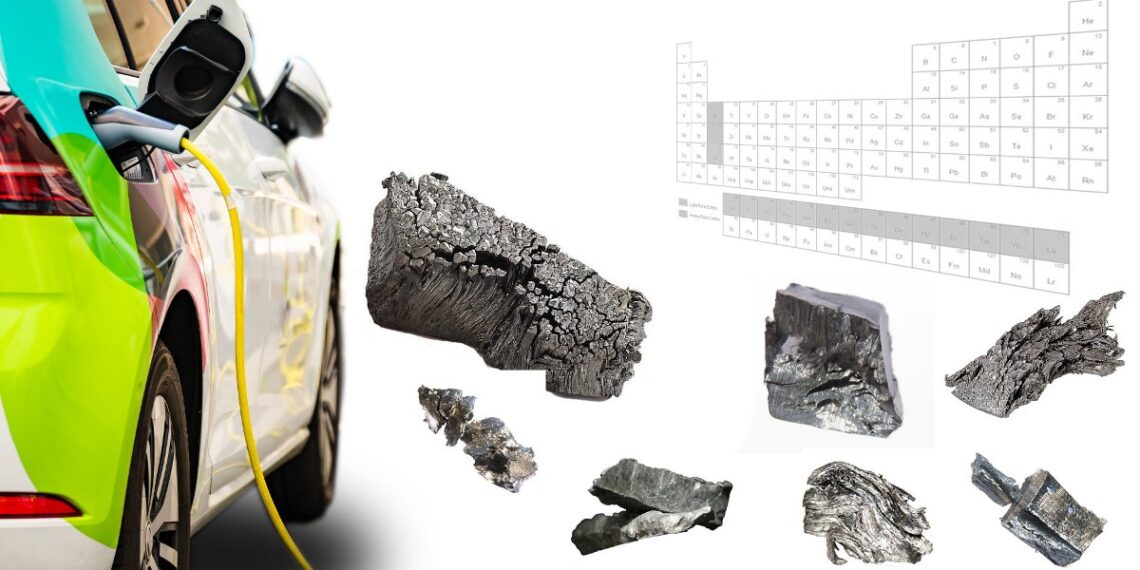In geology and mineralogy, a mineral or mineral species is broadly speaking a solid substance with a fairly well-defined chemical composition and a structure that occurs naturally in pure form.
It is vital note that the drive to towards renewable energy places mineral at the frontal role. Each type of renewable energy uses critical minerals in varying quantities, depending on the properties needed.
Aluminium and copper are most common in solar energy; iron and zinc in wind energy; nickel and chromium in geothermal energy; and graphite, nickel, and cobalt in producing electric batteries.
But what are those critical material ??? According to the World’s Economic Forum, they are;
1. Lithium
Lithium is a vital ingredient for energy storage in both batteries and electric vehicles. It is deemed a “pillar for a fossil fuel-free economy” by the United Nations, lithium is expected to replace fossil fuels as the world’s dominant commodity in coming years as demand for the alkali metal grows.
Already a major component of the electric mobility movement, lithium and the batteries it powers is integral to both the transport and energy sectors.
However, while the use of lithium-ion batteries is well known within the electric vehicle sector, why is lithium important for renewable energy?
As many people know, the global demand for lithium is on the rise, driven by the increasing adoption of electric vehicles (EVs) and renewable energy storage solutions.
Without lithium, the efficiency and ability to implement renewable energy will be limited. As such, the element is critical to the development of low-carbon power opportunities across the world, and will dictate how fast the global transition can happen.
Especially for nations with high intermittency, increasing energy needs, or demand for self-reliance, lithium-ion batteries for energy storage provide the perfect solution to maximize the use of solar, wind, and tidal energy and dependency on fossil fuels.
The shift to renewable power can only be successful with the use of lithium.
The negotiations that took place at the 2021 UN climate conference (COP26) showcased the steps needed to reach net-zero goals: improving renewable energy infrastructure, divesting from fossil fuels, increasing renewable energy capacity, and developing energy storage systems for grid-scale use.
2. Cobalt
Cobalt is crucial in helping batteries charge and discharge effectively. Cobalt is used in many alloys & super alloys to make parts in aircraft engines, gas turbines, high-speed steels, corrosion-resistant alloys, and cemented carbides; it is used in magnets and magnetic recording media. It is also used as a catalyst for the petroleum and chemical industries.
Cobalt plays an important role in renewable biogas technology. Biogas is a methane-based energy carrier and is widely used for delocalised electricity and heat production or as a renewable replacement for natural gas.
Biogas is an environmental technology which produces energy-rich gases by degrading complex organic materials including those found in landfill waste, sewage sludge, bio-waste treatment and certain species of crops.
The fermentation involved in biogas production can be improved by adding small amounts of cobalt sulphate, cobalt chloride, cobalt carbonate,
3. Copper
Copper is a highly efficient conduit, it is used in renewable energy systems to generate power from solar, hydro, thermal and wind energy across the world. Copper helps reduce CO2 emissions and lowers the amount energy needed to produce electricity.
In many renewable energy systems, there is 6 times more copper than in traditional systems. Copper is one of the best renewable resources.
It is one of the few materials that can be recycled over and over again without a loss in performance.
Renewable energy sources provide nearly one-quarter of the world’s power, and copper plays an important role in making it as efficient as possible with minimal impact on the environment.
Copper is well-known for its strong sustainability credentials. Not only is the red metal supporting the shift to a circular economy, but it’s also helping to accelerate the transition to renewable energy.
A key component of electrical wiring, copper plays an important role in the capture, storage and transmission of renewable energy. Meanwhile, the demand for copper is already on the rise and will continue to grow as the green energy transition gathers pace.
4. Nickel
Nickel is a core component in both batteries and wind turbines. The role of nickel within the renewable energy revolution explores how the industry is working to mitigate its environmental impact.
As the global society makes strides towards a more sustainable future, certain industries and their components have been thrust to the forefront of these efforts.
The metals industry, with a particular emphasis on nickel, plays an essential role in supporting this progression. This is primarily due to its extensive utilization of renewable energy technologies and battery production.
These technologies are key elements in implementing clean energy solutions such as geothermal power, electric vehicles (EVs), and nuclear energy, among others.
Notwithstanding its inherently energy-intensive production process, nickel’s recyclability makes it instrumental in fostering a circular economy where resources are used optimally, and waste generation is minimised.
5. Rare earth metals
Rare earth minerals are major components of renewable energy technologies, however, the types and quantity of minerals required vary by technology.
Neodymium and praseodymium, for example, are used in the production of magnets which are key to the operation of wind turbines and EV motors.
Those elements strengthen the magnets, while other minerals (dysprosium and terbium) make them resistant to demagnetization.
Likewise, while silicon is still the dominant semiconductor metal used in solar PV cells, rare earth minerals cadmium and gallium are increasingly being used due to their conductive deficiencies.
Without an abundance of rare earth minerals, renewable energy technologies would not exist in their current form or would be highly inefficient when compared with traditional generation methods such as oil, coal and gas.
Similarly, technological advancements such as those between silicon solar PV and cadmium or gallium solar PV cells, could not occur.
It is due to the availability of large amounts of rare earth minerals for use in renewable energy technologies (and other technology advancements) that the market and quality of renewable energy sources have been able to flourish.
For records, the United States has the world’s largest proven coal reserves. It is also rich in copper, lead, molybdenum, phosphates, rare earth elements, uranium, bauxite, gold, iron, mercury, nickel, potash, silver, tungsten, zinc, petroleum, natural gas, timber, and arable land.
Again, Russia’s natural resources reserves are worth $75 trillion by Statista’s estimate. This amount incorporates, among other things, coal, oil, natural gas, gold, timber, and rare earth metals.
Russia’s Ministry of Natural Resources and the Environment estimated the total value of the country’s mineral reserves at the end of 2018 to equal $1.44 trillion.
It also holds the world’s largest proved natural gas reserves at 1.32 quadrillion cubic feet, accounting for nearly 20% of the global total as of 2020.
Russia also has the second largest gold reserves at 6,800 tons, or more than 13% of global total as of 2023. Russia was the world’s third-largest crude oil producer at 12% of global supply in 2020.
Russia proved oil reserves were the world’s sixth largest at an estimated 107.8 billion barrels. In industrial diamonds, the country accounted for 37% of 2022 global production and 46% of the commodity’s reserves.
[Featured Image Credit]
YOUR VIEW: Which of these materials do you think will affect global economy the most?












